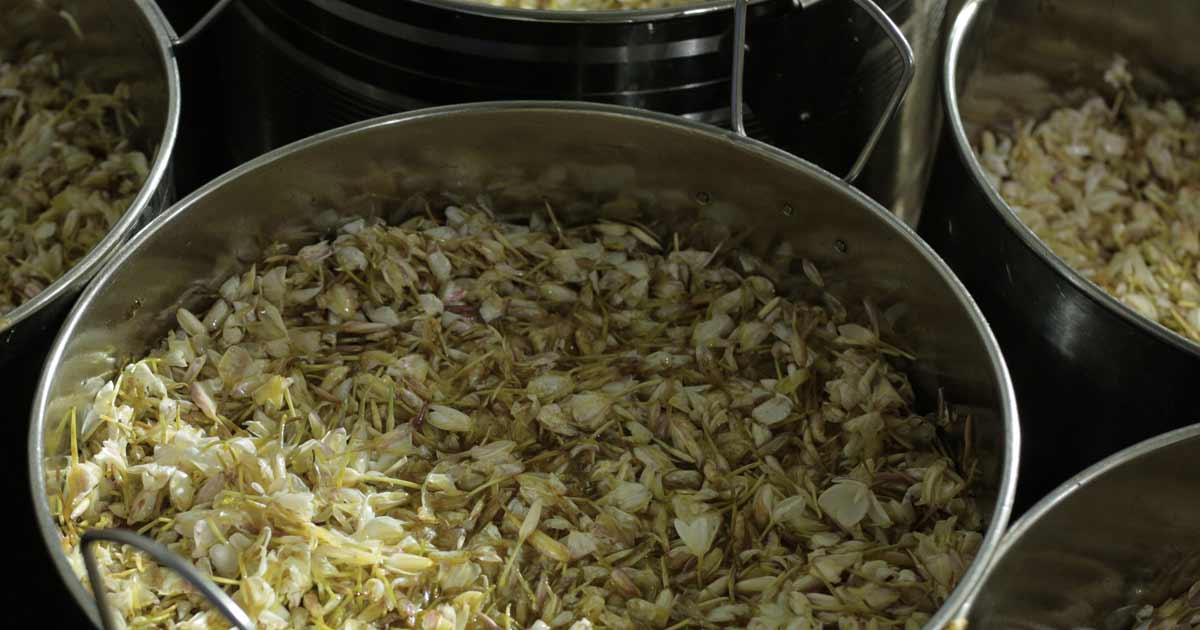Cette publication est également disponible en :
Français
This article was published in partnership with Mane.
Combining tradition and innovation, the French composition house is bringing together the historic technique of enfleurage and supercritical fluid extraction to introduce original notes to perfumers’ palette, with minimal impact on the environment.
Delicate jasmine flowers and tuberose scattered over wooden frames spread with an immaculate layer of fat – such a scene could have been observed up until the Second World War. The technique of enfleurage, which is based on the capacity of fatty substances to absorb odourous molecules, has existed since Ancient Egyptian times and it became common practice in the Grasse region during the 18th century. Enfleurage makes it possible to extract flowers that are too fragile to handle the heat from distillation. Flowers such as jasmine, tuberose and daffodil are placed onto a mixture of animal fats (pork and beef) at room temperature, then they are replaced with fresh flowers over several days or even weeks until the fat is saturated with fragrant substances. Rose centifolia, cassie and orange blossom, however, are submerged in copper vats filled with animal fat that is heated to 40-45°C, then they are left to infuse until the next day, before being replaced with fresh flowers. After this hot or cold enfleurage, the fat, called pomade, is purified with alcohol to produce an absolute. This process, which is costly both in terms of time and labour, fell into disuse in the 1950s with the widespread use of solvents such as hexane.
However, in 2015, Mane had the idea to reinvent enfleurage by associating it with the technique used to produce Jungle Essence extracts – supercritical fluid extraction. This type of extraction, which is more eco-friendly than other methods, makes it possible to produce an ingredient that is closer to the scent of the original raw material. This method has been used since the 1970s and it has an increasing significant role in perfumers’ palette. There is, however, the disadvantage that the method cannot be used for all ingredients, especially since it requires installing expensive facilities which can therefore not be built close to every location where the raw materials are harvested. “It requires time to transport the material prior to transformation, which is not a problem for wood or spices, but until now it prevented us from treating flowers or leaves which are more fragile,” Serge Majoullier, perfumer at Mane, explains. “We had to create an intermediary product that was easy to produce as close to the fields as possible and then transport it to our laboratories where it would be extracted with a supercritical fluid.”

The enfleurage technique, which was initially designed for fragile ingredients, met these requirements, but it required some modifications. When developing this new enfleurage method, Mane had to run several tests to guarantee a satisfactory result, both in terms of scent and yield. “We carried out the tests in India, in the Tamil Nadu region, where several raw materials are produced,” Serge Majoullier tells us. The first step? Choosing which fatty substance to use. Animal fats had to be eliminated for ethical reasons, so vegetable oils were the obvious choice. However, the lucky winner had to tick several boxes: be odourless, easy to produce and organic. “We tested many oils,” the perfumer assures us. “A lot of them worked, but some were more efficient than others depending on the raw material used. Eventually, we decided on jojoba oil.”
Mane then needed to develop the actual process – duration of the enfleurage, oil temperature, number of baths (the number of times fresh flowers are submerged in the same vat of oil). There are many factors that vary according to the ingredients used and the molecules sought after. The exact recipe remains a secret, given that the process cannot be patented. This new-generation enfleurage technique produces oils. These E-Oils are then transported to the Mane laboratories in Le Bar-sur-Loup, near Grasse, where they are extracted with supercritical fluid to become E-Pure Jungle Essence extracts.
The main advantage may therefore be considered a “green” method, which means E-Pure Jungle Essences can be used in natural perfumes and formulas with the “Cosmos Bio” label, unlike absolutes for example. This is a real asset in a world where brands and consumers are demanding natural products. Another benefit is that the resulting ingredients reveal an olfactory profile that is very close to the original raw material. The Jasmine Grandiflorum E-Pure Jungle Essence gives off shades of green, is slightly fruity and far less animalic than the absolute produced with the same flower. “It is an extremely accurate extract, we smell jasmine as we know it out in the fields,” Serge Majoullier tells us enthusiastically. Likewise, the Jasmine Sambac E-Pure Jungle Essence covers up the animalic side we find in the absolute, which is a bit medicinal or petrol-smelling, in order to showcase the more delicate and fresh notes of the flower. As for the Red Champaca E-Pure Jungle Essence, produced from champak, a flower that decorates Indian temples, it develops notes that remind us of orange blossom, honeyed and heady. This scent could for example flesh out a lily or lily of the valley accord. “A champak absolute does exist, but it is blood-red, so it is difficult to use for brands who wish to colour their perfume. On the other hand, our E-Pure is very pale,” the perfumer points out.
Three extracts are now available for Mane perfumers and others will follow. “In the future, we plan to transform other flowers or leaves in the same way,” Serge Majoullier reports. “For some raw materials, we can imagine creating several E-Pures – when we use supercritical fluid extraction, we can alter factors like temperature or pressure in order to preserve more molecules that will have an impact, as top notes, or alternatively as base notes. There are many possibilities for increasing the perfumers’ palette and for stimulating their creativity.”








Comments